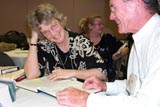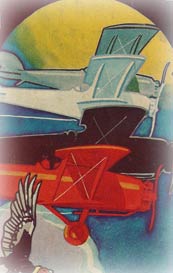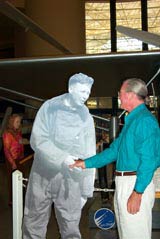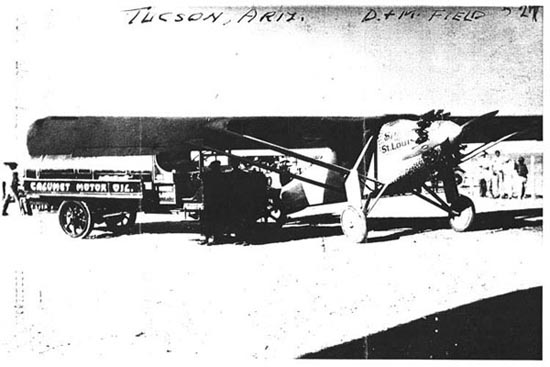|
Anyone alive and mostly conscious during the 20th century has heard of Charles
Lindbergh. He was, after all, the first aviator to cross the Atlantic Ocean solo. Lindbergh's trans-Atlantic flight took off from Roosevelt Field, Long Island, in May, 1927. In case you haven't heard, he was successful and, among thousands of publications around the world on the same day, the Hazelton Standard-Speaker (PA), May 24, 1927 reported on his arrival in France, below.
Hazelton Standard-Speaker (PA), May 24, 1927 (Source: newspapers.com)
 |
Before he left for Paris, Harry Guggenheim, a multimillionaire and aviation enthusiast, visited him at Roosevelt Field. "When you get back from your flight, look me up," said Guggenheim, who later admitted he didn't think there was much chance Lindbergh would survive the trip.
Aviation, July 11,1927 (Source: Web)
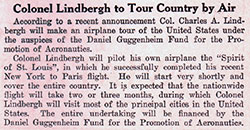 |
Lindbergh remembered and did call upon his return. It was the beginning of a friendship that would have a profound impact on the development of aviation in the United States. The two decided Lindbergh would make a three-month tour of the United States, paid for by a fund Harry and his father, Daniel, had set up earlier to encourage aviation-related research. The Daniel Guggenheim Fund sponsored Lindbergh on a three-month nation-wide tour, as described in Aviation magazine, July 11, 1927, right.
Flying the "Spirit of St. Louis," he touched down in all the United States, visited 92 cities, gave 147 speeches, and rode 1,290 miles in parades. The excitement generated by the tour stimulated common people and government officials to demand that airfields and other infrastructure be constructed. An explosion of aviation interest occurred after Lindbergh passed through town.
Lindbergh visited the Davis-Monthan Airfield once. He was
on that tour that started at Mitchel Field,
Long Island, NY, July 20, 1927, and ended at Mitchel
Field on October 23, 1927. The tour was a celebration of
his trans-Atlantic success.
WHAT WAS IT LIKE IN TUCSON ON THE
DAY OF HIS VISIT?
Lindbergh arrived at Tucson Friday September 23, 1927 at 2:00PM. The film below captures his arrival in a cloud of dust. He deplaned and inspected a cactus model of his airplane. He then rode in an open car to the University of Arizona and gave a brief speech (below). On the next morning he is shown departing. For your convenience, this film is also on YouTube and on Vimeo and can be viewed at the links.
A lot of ink has been laid on paper that describes Lindbergh's life and deeds. This Web page won't reiterate that. Rather, if focuses only on the things that are tour- and Tucson-related. There's plenty of information and links here that you may not find accumulated in one place.
An article describing Lindbergh's visit to Tucson (link inop 4/20/19) and the cactus replica of the "Spirit of St. Louis," the "Spirit of Tucson," is at the link (PDF, 3Mb). This is a great link (link Inop) summarizing
his 1927 Tour. You may see another image of Lindbergh on
tour here. He arrived at Tucson eastbound from San Diego, CA. He was fêted at San Diego, much as he was at Tucson. You may view a video (number F-0140) of Lindbergh in San Diego on September 21, 1927 at the link. The video is posted online by the San Diego Aerospace Museum. Please let me KNOW if the link expires. The SDAM also posts a number of photographs of Lindbergh at the SDAM Flickr Stream. Below is a map showing the route of his tour. He visited Tucson between San Diego, CA and Lordsburg, NM.
Lindbergh's 1929 U.S. Tour (Source: Web)
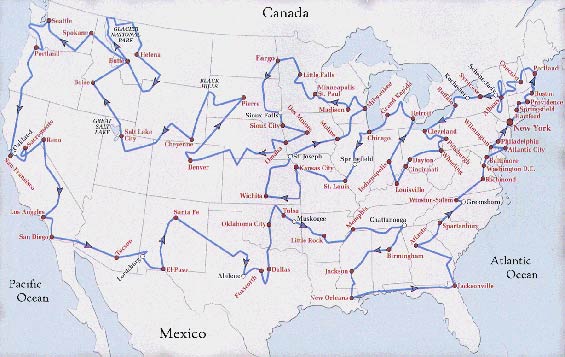 |
When Lindbergh visited Tucson the city
fathers were well-prepared. Below, retyped in about the same
font and format, from an original at the Arizona Historical
Society library, is the agenda they built for him. He was
greeted in Tucson by about 20,000 people.
LINDBERGH
DAY
Program |
| |
HEADQUARTERS
SANTA RITA HOTEL |
12:45
– Mayor’s committee meets at Santa Rita
hotel to go out to aviation field.
1:30
– Department of Commerce red monoplane piloted
by Philip Love and carrying D.E. Keyhoe, manager of
tour and C.C. Maidmont, mechanic, will arrive at the
new Davis-Monthan airfield.
2:00
– Colonel Charles A. Lindbergh, flying his silver
monoplane, Spirit of St. Louis, will arrive at airfield.
Parking space north and west of field and along Alvernon
Way and Broadway available to cars. No cars or persons,
except mayor’s committee, will be allowed on field.
2:45
– Colonel Lindbergh will drive through Pastime
Park so that all war veterans may see him.
3:00
Colonel Lindbergh will speak for 20 minutes at football
field at University of Arizona. Grandstands will be
reserved for grade and high school children unattended
by adults. Parking space on Polo field and north and
west of gymnasium available. Loud speakers for 25,000.
4:30
to 7:00 –Colonel Lindbergh’s own time.
6:45
– Banquet at University Commons at which Colonel
Lindbergh will speak.
8:00
– Dance at Gymnasium. Everybody Welcome. |
ROUTE
TO AVIATION FIELD |
| Go
east on Congress Street through Subway to Ninth Street
(first street north of Subway); Turn to right; East on
Ninth Street to Park Avenue; South on Park Avenue to Broadway;
East on Broadway, past Country Club to Alvernon Way (northeast
corner Randolph Park); then two miles south to Aviation
Field. |
ROUTE
OF PARADE |
| Aviation
field, north on Alvernon Way to Broadway; West on Broadway
to Park Avenue; North on Park Avenue to Speedway; West
on Speedway to Stone Avenue; Thence to Pastime Park, returning
same route to Sixth Avenue and Speedway; South on Sixth
Avenue to Fourth Street; East on Fourth Street to University. |
NO
CARS TO ACCOMPANY COL. LINDBERGH TO PASTIME PARK |
KEEP
OFF THE FIELD |
Keep
Route of Parade Clear |
Let
Arizona distinguish herself by so doing. |
According to the Register, the "red monoplane"
cited in the agenda above was Fairchild FC2 NS-7, registered
with the Department of Commerce. It landed Friday at 1:30PM,
with Lindbergh following at 2:00. You can see the Fairchild briefly in the film above. Refer to page
22 of the register for Lindbergh’s signature,
and those of Love, Keyhoe and Maidment who accompanied
Lindbergh in the red Fairchild. An interesting aside is
that Phil Love is one of only two other pilots (the other
was Major James Lanphier) to fly the Spirit of St. Louis
solo.
When he got to the field in the mid-afternoon, he spoke
to the crowd. Here is the text of the speech that Lindbergh
delivered to about 5,000 people on September 23rd at the
football field on the University of Arizona campus. Although
his itinerary alloted 20 minutes for these words, I can't
believe he took the full time. The motion picture film shows him at the podium delivering this speech.
“Citizens of Arizona, we are just beginning
the third lap of our tour which is taking us to all
the important cities in the country. This tour was organized
for the purpose of promoting aviation in the United
States, and it is under the auspices of the Daniel Guggenheim
Fund for the Promotion of Aeronautics.
There is no other means of transportation by which
a tour of this schedule could be made. Only once during
this entire tour have we been delayed and that was not
due to mechanical trouble, but due to weather conditions
in the New England states. Airplanes of today are reliable,
fairly economical, and high in performance. The engine
in The Spirit of St. Louis is the same in which the
trip across the Atlantic was made.
Your interest in aviation is manifested by your attendance
here today and by your splendid airport in Tucson. It
should be the object of every city to maintain equally
as good airports as here, and that is one of the purposes
of this tour. I thank you." |
With that, Lindbergh retired to the Santa Rita Hotel in
Tucson, where he met briefly with reporters, then rested
before an evening of activities, including dinner with 400
guests. According to the Register, he departed east to Lordsburg
at 7:45 the next morning. Today the Santa Rita is the Clarion
Hotel, at 88 E. Broadway Blvd., serving terrific northern Mexican
cuisine in the restaurant, "Cafe Poco Cosa" (note: "Cafe Poco Cosa" has moved and is now at 110 East Pennington St., Tucson, AZ; it is worth your visit).
---o0o---
WHERE DID HIS AIRPLANE STAY?
While Lindbergh went about his tour duties, NX211,
the "Spirit of St. Louis", stayed behind at the
airfield. Below is an image of the airplane while on the
ground at Tucson. This image came from the collection of
Mrs. Charles Mayse, via Mr. Cassagneres (see left column).
Her husband, Charlie Mayse, a Golden Age pilot from the
Tucson area, signed the register ten times. Please see
this link on this site for additional images of NX-211 on
the ground at Tucson.
What looks like a fuel delivery was probably not. The truck
was probably supplying motor oil and not gasoline, as gasoline
is not, and from their Web site
never was, a product Calumet provided.
---o0o---
WHAT WAS IN THE NEWS REGARDING HIS
VISIT TO TUCSON?
Considerable press coverage appeared around his visit. Beginning
on September 9th, The "Tucson Citizen" listed the
names of the reception committee for Lindbergh's visit. The
committee included a number of Gold Star mothers of local
aviators. Among them are, "Mesdames Luke, Davis and Monthan."
Of the last two the article states, "The new aviation
field which Lindbergh will be asked to dedicate will in all
probability take the name of the old field, 'Davis-Monthan'
and committeemen deemed it only proper that the mothers of
the aviators be present on the Mayor's reception committee." Both these women are seen on the dais with Lindbergh in the movie film.
On September 22nd, the "Citizen" headlined, "PLANS
PERFECTED BY LOCAL COMMITTEE TO GREET FAMOUS FLYER: Conqueror
of Atlantic Due to Reach Field at 2 o'Clock, Which Will Be
Signaled By Mighty Blast of Tucson Whistles".
The article heralded the arrival of the Lindbergh entourage
the next day. It reviewed his itinerary and introduced the
"red monoplane", its pilot Phil Love, and its passengers
Keyhoe (writer) and
Maidment.
Below is an image of that monoplane, from a period magazine
advertisment for Fairchild aircraft. The placard on the door
describes the Lindbergh Goodwill Tour, and its sponsorship
by the Daniel Guggenheim Foundation grant. You can also see this airplane taxiing in the movie film. It was red in color. Note how the wings could be folded.
This same article also lists a group of Navy planes flown
in from San Diego on the 22nd and the morning of the 23rd
to participate in the activities. Refer to Register page 22, just above
Lindbergh's signature, for pilots McGomery, Radford, Greber,
H.R. Bogusch, and Richardson. They departed on Saturday the 24th,
just before Lindbergh's takeoff toward Lordsburg.
Also on the 22nd, the "Citizen" headlined that,
"LINDBERGH IS GIVEN RIGHT TO HUNT BUFFALO", and,
"...America's ace of aces, will be granted special permission
to shoot a bull buffalo and two deer in the Kaibab forest
during his coming visit to Arizona."
On the 23rd, the "Citizen" headlined the day's
activities. What a high time it was: "VAST THRONG HERE
TO SEE AIR VIKING: Notables From All Over Ariz. Participating:
Seven Hours of Hearty Hospitality Is Day's Program".
It reports, "His airplane circled over the city three
times before going to the field. An ovation of thousands of
automobile horns greeted him as he landed." "Five
Navy planes were lined along the field, having come in from
San Diego." And, "Leading hotels last night turned
away a large number of applicants for rooms, all available
space having been previously taken by advance reservations,
many of which had been on file for several weeks time."
On the late afternoon of the 23rd, Lindbergh granted an interview
with ten members of the fourth estate at the Pueblo Club.
Their headlines on the 24th: "SOUTHWEST SPECIALLY ADAPTED
TO AVIATION, LINDBERGH'S OPINION: Year-Round Conditions Here
Are Best, Says Flier In Interview With Press; No Air Pockets
Here to Endanger Traffic". They reported, "His tanned
face bore a sincere expression and his keen, rather small
eyes reflected a mature mind in a youthful frame." Lindbergh
speculated for reporters that, "There will be three main
transcontinental routes in the future, one the northern, another
the central, and the third a southern route, which will pass
through Arizona.
"Time is worth more to Americans than the people of
any other country, and for this reason, he pointed out, commercial
aviation will soon become a great factor in our transportation."
They reported that Lindbergh felt, "The present tour
has not been as tiring as he expected it to be.... He has
had between 275 and 280 flying hours in the Spirit of St.
Louis, and has traveled about 25,000 miles with the original
motor, without overhauling."
Also reported on the 24th in a separate article, "The
Spirit of St. Louis motor which carried him across the Atlantic....was
tuned up shortly before eight o'clock this morning, and at
7:50 a.m. he took the air to start the last third of his gruelling
[sic] tour of the country.
"Slipping easily through the air, the silver-toned plane
circled about the city, made an air visit to Pastime Park,
then returned to swing about the city until a few minutes
after eight o'clock, when he pointed the Whirlwind-motored
nose of the plane eastward to Lordsburg, N.M. At Lordsburg,
he was due to make a brief visit, taking the air after an
hour's stay for El Paso. Enroute to that point, he will pass
over and circle about Silver City, N.M. and Fort Bayard, N.M."
In retrospect, the press found that, "Certainly the
visitor acted the gracious guest. He agreed to all requests
of the aviation committee, went where he was scheduled, shook
hands with those presented to him, posed for pictures at the
field, on the campus and elsewhere, and on occasion produced
the smile which has added greatly to his popularity. But he
did draw the line on autographs, at least in public, stepped
slightly back when crowded by overenthusiastic women, and
avoided answering questions which he deemed too personal."
---o0o---
The four photographs below come to us from Ty Sundstrom as stills from a movie film of Lindbergh's goodwill tour around the U.S. Mr. Sundstrom states they are from a "yardsale" film, " ... from Lindbergh's United States Guggenheim tour and were taken on September 1st, 1927." September 1st would place Lindbergh in Pierre, SD, westbound in his tour.
Lindbergh and Documents on the Horizontal Stabilizer
(Source: Sundstrom)
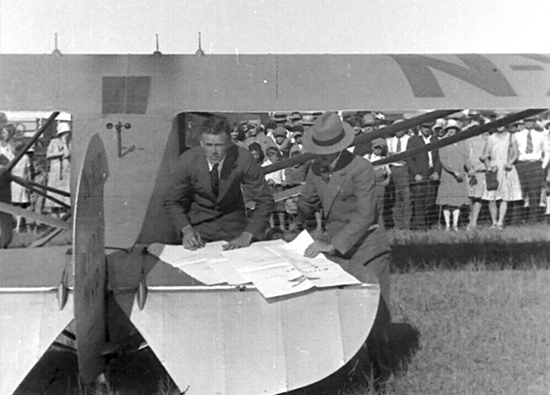 |
Lindbergh can be seen in the images above and immediately below, hatless, doing some paperwork on the horizontal stabilizer of his airplane. He looks like he might be signing souvenir posters. Indeed, he is signing posters similar to the one shared with us by site visitor Linda Roark, below, right, from the link.
Souvenir Poster Signed by Lindbergh, 1927 (Source: Web)
 |
The description of the poster (from an auction site, so I don't know how long the link will be valid) states,
"Charles Lindbergh: Signed Spirit of St. Louis Poster. On May 21, 1927, Charles Lindbergh stunned the world when he flew from New York to Paris in the Spirit of St. Louis. Literally overnight, he became the most famous man in the world. Just about two months later, Lindbergh and his plane began a sweeping national tour sponsored by multimillionaire Harry Guggenheim. With its designated purpose being the generation of increased public interest in, and support of, aviation, Lindbergh and The Spirit of St. Louis visited 48 states and landed in 92 cities from July 20 through October 23, 1927. For those larger cities on the flight path, but not on the tour, Lindbergh would fly low above a waiting crowd and drop a canvas tube containing one of these signed posters. With a great image of the legendary plane, the poster carries a salutation and indirect apology - "Because of the limited time.....it is impossible for the 'Spirit of St. Louis' to land in your city". The poster is enhanced by a spectacular signature, almost 3" long and over 1" high: "Charles A. Lindbergh". 19" x 26.5" sight size. Some toning and spotting, folds, a slight tear and small damp-stain in the lower left corner, else very good."
Below, the anemometer-like cups to the left of Lindbergh's head operate the wind-powered generator for the earth inductor compass.
Lindbergh and Documents on the Horizontal Stabilizer
(Source: Sundstrom)
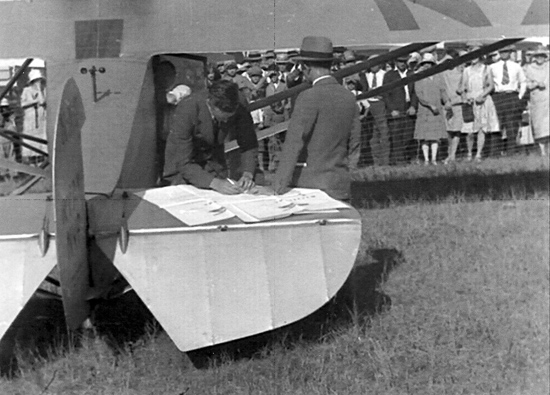 |
Below, we might be seeing Lindbergh behind the airplane between the wing struts. The famous lack of windows and forward view in the "Spirit of St. Louis" are well-illustrated in this photograph, as are the vents for the large fuselage fuel tanks visible as three inverted "L"-shaped tubes protruding from the top center of the wing. These can also be seen from the rear in the top photograph.
The machined metal of the engine and nose cowling is shown well. This is a process called "engine turning", which looks very rich and elegant, but was allegedly used to mask tooling marks that were inevitable on the hand-formed cowling. The tube protruding nearest from the left wing is the ram air pitot mast, used to measure airspeed.
Spirit of St. Louis at Pierre, SD
(Source: Sundstrom)
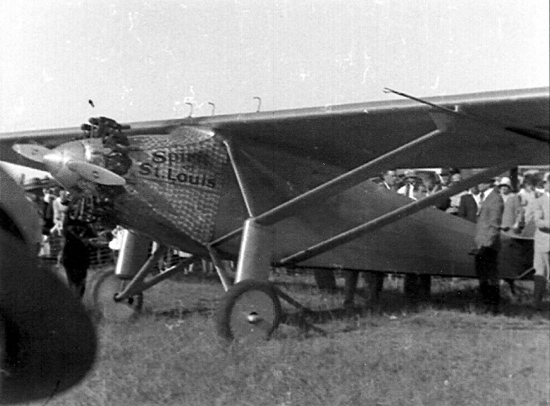 |
An interesting article, below, appeared in the August, 1930 issue of Popular Aviation magazine (PA). It describes the long-range fuel tanks installed in the "Spirit of St. Louis."
Long-Range Fuel Tanks, Popular Aviation, August, 1930 (Source: PA)
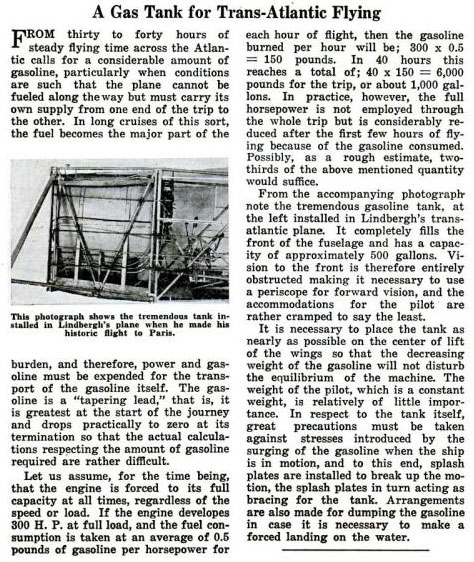 |
Below, the rear of the airplane has been lifted clear of the ground (note the tail skid is elevated above the grass) and it appears the men are turning it away from the fence and the crowd, perhaps in preparation for startup and departure from Pierre. From the positions of the control surfaces in this photograph, the control stick in the cockpit is toward the left, in the full forward position, and the left rudder pedal is depressed.
Spirit of St. Louis at Pierre, SD
(Source: Sundstrom)
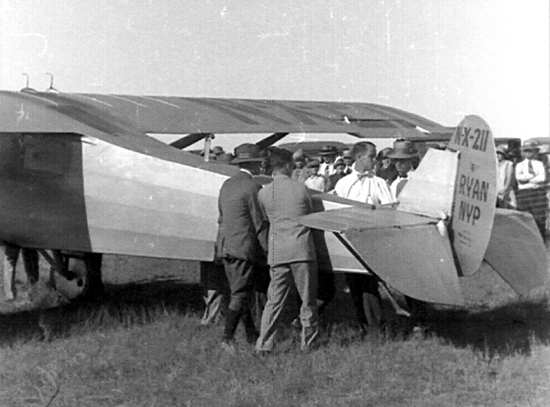 |
---o0o---
Dossier 2.1.11
THIS PAGE UPLOADED: 04/13/05 UPDATED: 05/01/06,
04/02/07 (movie), 10/12/07, 01/28/08, 04/14/08, 02/02/09, 06/06/11, 01/03/12, 06/17/14, 12/24/14, 04/20/19, 08/09/20
|

